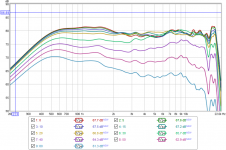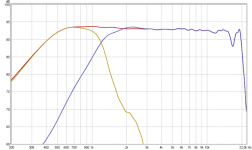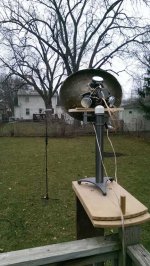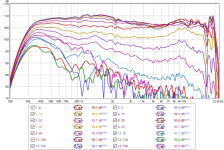Lol. A post somewhere from Bill Waslo clued me into the process and it kinda clicked from there. Last weekend I tried to get there by using dual channel measurements, looking at the phase and impulse delay on the hf section. I came close but not quite where I wanted to be. This time I flattened the response of the mr and hf section, took a measurement of them together, then tweaked the hpf and lpf as well as delay on the hf until it fell into place. Didn't take much really, but it can be better.
I made some changes to the port configuration which I'll detail later. For now here's a new xo I worked up. Acoustically it's at about 1.2khz. It could use some more work but not bad really! I don't have as much overlap on the hf and mr that I thought I'd need but I think that phase looks pretty good for a first crack. Didn't take me long to arrive at that.
I also have some open cell throat plugs made for this wg that I use in my main system. My hope was that the foam might "clean up" some of the reflections from the ports (not that I'm seeing much in the way of reflections) due to the longer distance traveled through the foam vs the main wave. Measurements out to 70° didn't show any change other than the normal attenuation.
I just might drag this thing outside this weekend for some better measurements. Sunday looks like 40's with little to no wind.
Nice !!!
Nate - if the polars hold up that well then, yes, that is incredible. Its one thing to get a flat response along any one axis with DSP, but how well does that hold off-axis?
I looked at several other axes and the phase held up. Mind you this is done with standard IIR filters......there's no FIR phase correction. Doing the FIR phase correction would be a piece of cake and I don't see why it wouldn't hold up off axis as well.
Edit: the fr, of course, is determined by the wg. The response with the phase I showed is 20deg which is the listening angle I design to be flat. The 0deg still shows the axial hole that starts to go away off axis and there's the "bunching" around 7khz that I don't like.
Edit: the fr, of course, is determined by the wg. The response with the phase I showed is 20deg which is the listening angle I design to be flat. The 0deg still shows the axial hole that starts to go away off axis and there's the "bunching" around 7khz that I don't like.
Last edited:
Nate,I'm still setup for measurements in the basement so I figured I'd get the polar response quick with the new xo......3ms gate.
The polar response looks very good, what is the horn wall angle and overall horn depth?
I'm curious what SPL can be reached before distortion hits 10% (or so), if it can hit 120+ a pair would make a very nice compact light weight center fill for my SynTripP cabinets.
Art
I would certainly play with a design like that if I still did that kind of thing, but retired, I just don't have the energy.
Art - it's a 90x60 waveguide that's 8" deep. I can do some measurements at higher drive levels and post the distortion plots, but I can tell you that I doubt my mic can handle 120dB. I'm in town and somebody would call the cops for sure. That said I am interested and I'll look into it after I find my ear plugs.
The limiting factor here is the 1" vc compression driver. As it sits it's -3dB at 1.2khz after cd comp with a 1st order hpf at 1.6khz. Swapping in a more capable cd would be easy. I have some 4552nd in my main system (which is what this wg is actually designed for) but I don't want to pull them out. Actually it wouldn't be easy as far as physically mounting the thing goes. The 4524 I'm using has a plastic throat flange where I can access both sides of the mounting bolt. The current setup is pretty sketchy due to the proximity of the mids. When I go to build a new horn I'll have to either drill counterbored holes inside the horn to mount the cd (then plug the holes) or have a removable cd mount plate that would then mount to the horn.
The limiting factor here is the 1" vc compression driver. As it sits it's -3dB at 1.2khz after cd comp with a 1st order hpf at 1.6khz. Swapping in a more capable cd would be easy. I have some 4552nd in my main system (which is what this wg is actually designed for) but I don't want to pull them out. Actually it wouldn't be easy as far as physically mounting the thing goes. The 4524 I'm using has a plastic throat flange where I can access both sides of the mounting bolt. The current setup is pretty sketchy due to the proximity of the mids. When I go to build a new horn I'll have to either drill counterbored holes inside the horn to mount the cd (then plug the holes) or have a removable cd mount plate that would then mount to the horn.
Very impressive results Nate!
Looking forward to hearing more about the port details as I'm set on a similar path.
Would be interested in seeing the individual LF and HF output overlayed over the graph you showed earlier to get an idea of how the XO looks.
Looking forward to hearing more about the port details as I'm set on a similar path.
Would be interested in seeing the individual LF and HF output overlayed over the graph you showed earlier to get an idea of how the XO looks.
Thanks Nate. Looks alot like a standard LR4. But phase shift is minimal. Cool stuff.
Looks like the Celestion fall of pretty early? Or is it do to the gating?
Looks like the Celestion fall of pretty early? Or is it do to the gating?
Nate,Art - it's a 90x60 waveguide that's 8" deep. I can do some measurements at higher drive levels and post the distortion plots, but I can tell you that I doubt my mic can handle 120dB. I'm in town and somebody would call the cops for sure. That said I am interested and I'll look into it after I find my ear plugs.
The limiting factor here is the 1" vc compression driver. As it sits it's -3dB at 1.2khz after cd comp with a 1st order hpf at 1.6khz.
Wow, that is smaller than I thought looking at the pictures, surprising the pattern control down (relatively) low. I am interested because of the lower cost HF driver, hard to justify much expense for the amount of shows I do anymore, but these could be used in a number of applications.
If you point the horn up, and measure at 2 meters, your mic should take the SPL. With it's pattern control and windows closed this time of year I doubt your neighbors would even hear it 😉.
Art
Nate,
That is a compact horn. What are the mouth dimensions and what is the theoretical low frequency with horn loaded pattern control?
That is a compact horn. What are the mouth dimensions and what is the theoretical low frequency with horn loaded pattern control?
Fredrik - yeah that's where the mid falls off. A larger port with less volume in the mid chamber ought to extend the response. I'm still working on that.
Art - I haven't got to the higher level distortion measurements yet but at 95dB there's about 2% 2nd hd at 1.1khz........that is due to the hf driver. With a more standard LR type xo higher up this is improved.
xrk - the mouth is 18"w x 13"h.........that's to the point where the wg would be tangent to a baffle if there was a baffle. The wg extends further with a 1.625" radius round over. I designed the thing thinking that the 13" vertical dimension should just get me control to 1khz where it was originally designed to cross to a 15" midwoofer.
Art - I haven't got to the higher level distortion measurements yet but at 95dB there's about 2% 2nd hd at 1.1khz........that is due to the hf driver. With a more standard LR type xo higher up this is improved.
xrk - the mouth is 18"w x 13"h.........that's to the point where the wg would be tangent to a baffle if there was a baffle. The wg extends further with a 1.625" radius round over. I designed the thing thinking that the 13" vertical dimension should just get me control to 1khz where it was originally designed to cross to a 15" midwoofer.
Nate
Thanks loads! That should work just fine. Give me a day or so and I'll post back the results.
Thanks loads! That should work just fine. Give me a day or so and I'll post back the results.
Cool!
Here's the fr polars until Earl gets his posted and I can get mine done in ARTA. I had to rescale the level for every curve in REW - it seems Holm normalizes the level of the impulse peak on export. Tedius! I probably just had something set wrong on the Holm export.
This is an outdoor measurement with the mic and speaker 8' off the ground with an 8' measuring distance. 1/48 octave smoothing and gated at 8ms. Eq'd flat at 20°.
I also took a set of the vertical, rotated such that the bottom mid port would be "seen" by the mic and I think you can see the diffraction off the port. I haven't looked too closely at that data yet other than to make sure it was good.
Here's the fr polars until Earl gets his posted and I can get mine done in ARTA. I had to rescale the level for every curve in REW - it seems Holm normalizes the level of the impulse peak on export. Tedius! I probably just had something set wrong on the Holm export.
This is an outdoor measurement with the mic and speaker 8' off the ground with an 8' measuring distance. 1/48 octave smoothing and gated at 8ms. Eq'd flat at 20°.
I also took a set of the vertical, rotated such that the bottom mid port would be "seen" by the mic and I think you can see the diffraction off the port. I haven't looked too closely at that data yet other than to make sure it was good.
Attachments
I want to add that the data I'm showing here, and what Earl can hopefully work with is in no way meant to be a representation of "the" Synergy horn and what Tom Danley has done..........only my interpretation which really is just a test bed at this point.
- Home
- Loudspeakers
- Multi-Way
- Mini-Synergy Horn Experiment



